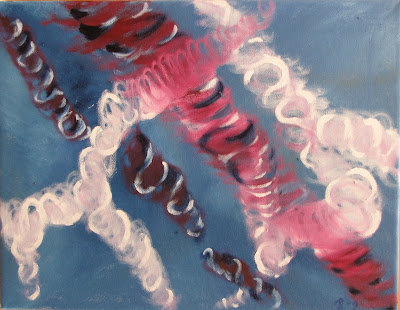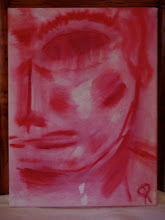
Running (or throwing or jumping) and painting (or drawing or carving) are both physical, solitary acts. We may run in a pack or paint in a class, but the experience is largely our own; to the runner and the painter, teamwork and collaboration are attainable, but they begin as largely abstract concepts.
Unlike team sports such as basketball or crew, the challenge of running is intensely personal. We are testing our physical limits, finding our threshold of maximum exertion, trying to hold concentration and relaxation together in perfect balance under intense conditions. It is a supreme experience of energy, powerful, and extremely difficult to sustain.
Unlike video or film, painting, too, resists collaboration. Even the act of writing, while largely solitary, lends itself to editorial input from others, and the words on the page can be changed at any time, and then changed back again. Painting is less easy to revise.
To either run or paint well requires a seeming paradox: discipline and control to produce fluidity and freedom. Harnessing energy to release it.
Running and painting are both sensual acts, but running is macro and external, painting micro and internal. Running engages all of the senses, a rich immersion in the physical world. But the sensuality is impersonal. Runners—and more generally, athletes—are to be seen, not touched.
Athletes are their own paintings, perpetual-motion sculptures. Runners are physically fit, and good running form is graceful, pleasing to the eye. We run in nothing but shorts, exposing our thin arms and muscular thighs, but the pleasure is distant and ephemeral, not sexual. Like the painting in the museum, the runner is to be admired from afar, not felt.
Painting, by contrast, is intimate, even erotic, soft and fluid, curvaceous, filled with color and light. The motions are smaller than running, though the experience can be as exhausting and intense, as the flow of energy through the arm is equally strong as through the legs.
Unlike running, when painting is done, something remains; energy is fixed. Running is like firewood, burning brightly and generating great heat for a limited time; painting is like the steel forged in the fire. Neither, of course, is truly permanent, but painting leaves longer traces.
My experience of energy is passing from athletics to art. Muscle strains and knee pain have prevented me from sustained or intense training in the past year or so. I have slowly come to accept the reality that I will have to be a more casual athlete from now on, recreational rather than competitive, running for my general mental and physical health, not as a primary means of self-expression. I have already given up sports like basketball and softball for fear of injury, as I feel neither capable nor interested in slowing down my approach. The game remains, but not the same force of energy.
At the heart of my love for athletics has been my experience of energy. It borders on the electric. I almost become another person when I step across the foul line onto the softball field or walk onto the basketball court, hyper-charged with an energy that feels as if it originates somewhere other than in myself.
But while my legs are no longer capable of channeling energy in the same way, the flow remains, entering my body involuntarily and eventually needing to find a way out. Fortunately, I can engage my arms, hands and wrists in the act of painting, where I can process the energy, energy which I am drawn to but do not fully comprehend.

No comments:
Post a Comment